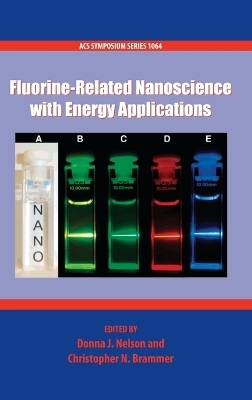
Fluorine-Related Nanoscience with Energy Applications
Oxford University Press Inc (Verlag)
978-0-8412-2610-4 (ISBN)
- Keine Verlagsinformationen verfügbar
- Artikel merken
The conditions of our overpopulated planet with ever-growing energy needs, fossil fuels in limited supplies, and inefficient energy use world-wide, are creating a global crisis. Science has a responsibility, as well as a grand opportunity, to solve these energy-based problems of society. Science's new nanotechnologies, and the creativity they bring, are particularly appropriate to solve these problems. For example, energy-saving lighting, coupled with improved
harvesting and conversion of sunlight into electric energy, will have a great impact on society's energy needs. Also, development of energy efficient and low cost fuel cells, which could eventually replace car engines, has a potential to improve everyday life greatly.
Nanomaterials offer an opportunity to develop new low-cost materials as environmentally friendly solutions and renewable energy sources, in order to meet society's energy needs. Fortunately, a wide spectrum of the scientific community has become interested in developing these nanomaterials in order to solve the above energy challenges. Nanomaterials offer unique mechanical, catalytic, electronic, and optical features, which are different from those of the analogous bulk material (1). This is
because nanomaterials have scale-dependent properties, due to quantum size effects, which means the nanomaterial size (10 - 100 nm) is smaller than the mean free path of their electrons. Thus, nanomaterials have great promise for use in harvesting solar energy, hydrogen production and storage, fuel
cells, catalysis, chemical, optical sensors, drug delivery systems (such as liposomes), and nanothermite reactions (2-4). Fluorine-containing nanomaterials generally have certain unique properties which are often improved relative to the analogous non-fluorinated nanomaterials, and which therefore could be engineered. Although fluorine has the highest electronegativity of all the elements, which means that bonds to fluorine are generally quite polar, it is also in the second period of the
periodic table, so it also has a small atomic radius and forms strong bonds. This produces the following properties, which also are characteristic of and bring great advantages to fluorine nanomaterials: high thermal and chemical stability, resistance to degradation by solvents, low flammability, low
moisture absorption, low surface tension or energy, low dielectric constant, and serving as a strong oxidant under high energy conditions (5). However, little attention has been given to fluorine-containing organic and inorganic nanomaterials, which are predicted to have these unusual characteristics. This book presents examples of four diverse classes of these nanomaterials.
Donna Nelson is Professor of Chemistry at Oklahoma University. Christopher Brammer is in the Department of Chemical, Biological, and Materials Engineering at the University of Oklahoma.
1. Introduction ; Donna J. Nelson and Dragan Nikic ; The Nature of Molecular Association in Functionalized Low-Dimensional Carbon Structures ; 2. Fluorinated Carbon Nanomaterials: XeF2 Fluorination of Graphene ; James S. Burgess, Jeffrey W. Baldwin, Jeremy T. Robinson, Felipe A. Bulat, and Brian H. Houston ; 3. Association of Representative Amides and Aminoalcohols with SWCNT As Revealed by 1H NMR ; Donna J. Nelson, Christopher N. Brammer, Panneer Selvam Nagarajan, and Paramasivan T. Perumal ; Fluorinated Porphyrins: From Organic Photovoltaics to Metal Nanocatalysts ; 4. Highly Fluorinated Porphyrins: From Ultra-Thin Films to Nanoparticles in Catalysis ; Alessandro Varotto, Gabriela Smeureanu, Amit Aggarwal, and Charles Michael Drain ; Energy Conversion Applications of Doped Complex Fluoride Lanthanides ; 5. Ligand Effects and Synthesis of NaYF4 Based Up and Downconversion Colloidal Nanophosphors ; Jingning Shan, Nan Yao, and Yiguang Ju ; 6. Nanofluorides for Environmentally Benign Lighting and Energy Conversion in Solar Cells ; Pushpal Ghosh, Chantal Lorbeer, and Anja-Verena Mudring ; Semiconductor Nanoparticles and Noble Metal Nanoparticles in Potential Fuel Cell Applications ; 7. Fluorinated Templates for Energy-Related Nanomaterials and Applications ; Mohammed J. Meziani, Fushen Lu, Li Cao, Christopher E. Bunker, Elena A. Guliants, and Ya-Ping Sun ; 8. Synthesis, Functionalization, Characterization, and Application of Controlled Shape Nanoparticles in Energy Production ; Simona E. Hunyadi Murph, Steven M. Serkiz, Elise B. Fox, Hector Colon-Mercado, Lindsay Sexton, and Matthew Siegfried ; Indexes ; Author Index ; Subject Index
| Erscheint lt. Verlag | 26.1.2012 |
|---|---|
| Reihe/Serie | ACS Symposium Series ; 1064 |
| Zusatzinfo | 85 b&w |
| Verlagsort | New York |
| Sprache | englisch |
| Maße | 158 x 232 mm |
| Gewicht | 416 g |
| Themenwelt | Naturwissenschaften ► Chemie ► Anorganische Chemie |
| Naturwissenschaften ► Chemie ► Organische Chemie | |
| Technik ► Elektrotechnik / Energietechnik | |
| Technik ► Maschinenbau | |
| ISBN-10 | 0-8412-2610-5 / 0841226105 |
| ISBN-13 | 978-0-8412-2610-4 / 9780841226104 |
| Zustand | Neuware |
| Haben Sie eine Frage zum Produkt? |
aus dem Bereich


